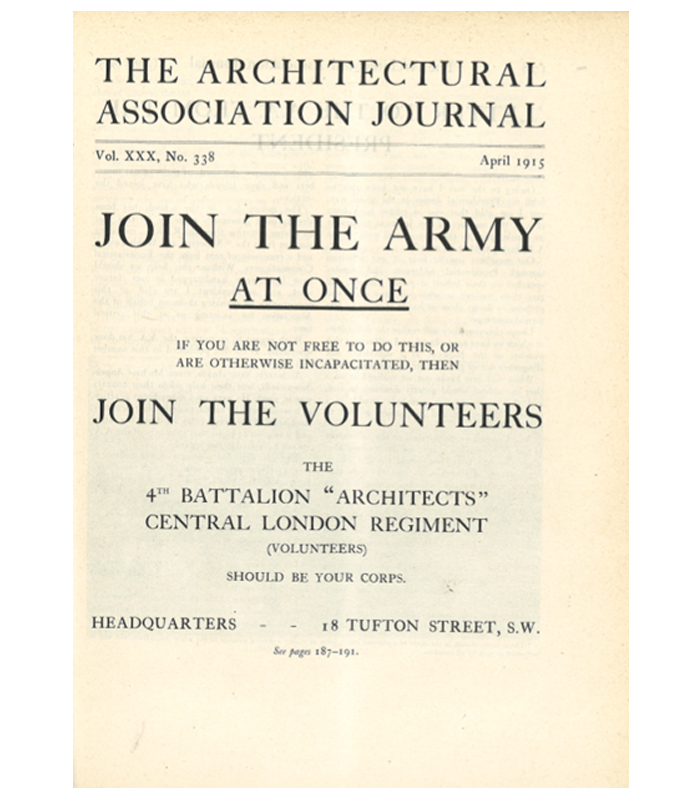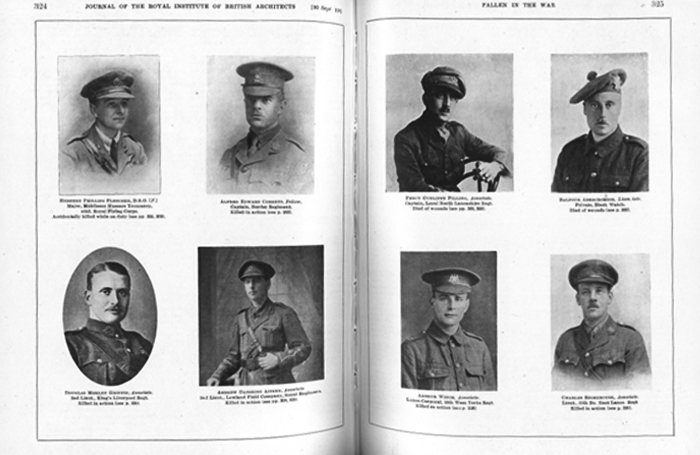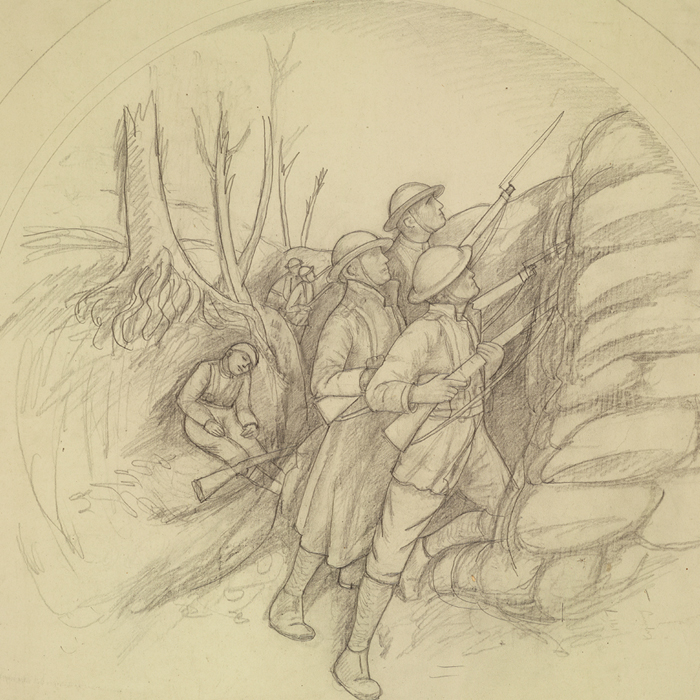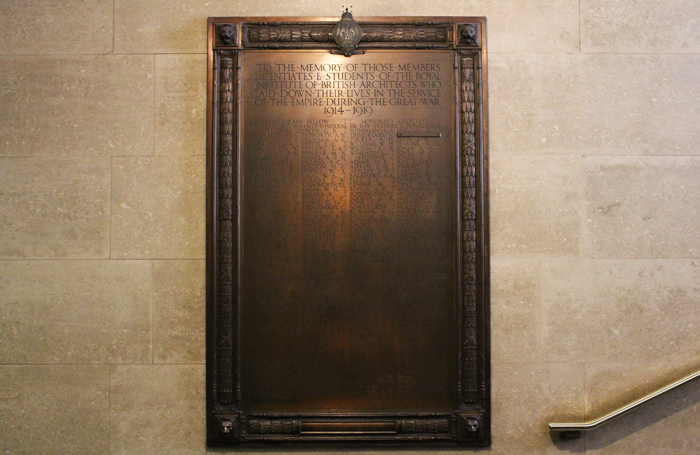On the battlefield and in civilian life, architects were part of the war effort from the start, writes Cathy Wilson.
The 27 June 1914 issue of the RIBA Journal featured a paper on an architectural tour for the University of Sheffield of France in 1913. The article ended with the author’s heartfelt wish to return for a similar tour in south France in autumn of 1914. Little were they to guess that the day after the journal was published, Archduke Franz Ferdinand would be assassinated in Sarajevo, and the subsequent chain of events would see Britain join a European war on 4th August 1914. Hundreds of RIBA Members would be in France on very different terms.

A call to arms
At the outbreak of war, those in the regular army and the reserves were sent into action. Kitchener (himself an RIBA Honorary Fellow) quickly initiated the call for volunteers to increase the size of the army. Many in the architectural profession were amongst those who joined up.
The President of the Architectural Association (AA), Maurice Webb joined the Royal Engineers and encouraged other AA members to do the same. The rush was so great that recruiting had to be stopped temporarily. The AA set up a War Service Bureau for any architect or architectural assistant wishing to enlist, not just in the Royal Engineers but in any regiment they wished, as long as there was space.
H.S. Davis, a corporal in the Royal Engineers, writing in the AA Journal in 1917 described how he and eight others walked together to Scotland Yard on 4 September 1914 and were rushed through the hundreds waiting to join up and admitted to the Royal Engineers, thanks to the influence of AA Secretary. He was first sent to Egypt in June 1915 and fought at Suvla Bay with the Australian forces in August 1915.
Another popular regiment was the Artists Rifles, officially known as '28th Battalion London Regiment’. The existing 1st battalion went to France in October 1914 and a second battalion was formed initially for 'Home Defence', with vacancies reserved for AA and RIBA members. The Artists Rifles became an officer training corps. Once commissioned, their officers served in regiments throughout the British Army.
The AA also set up a volunteer training corps, but strictly to provide training to those not yet eligible to enlist. But the overwhelming message was clear: if you were eligible to enlist, then you were expected to go.
"Rouse ye, ye builders! Cannot you hear the crumbling and cracking of the doomed walls of nations?......fling from you till a more fitting time your T-square and the tools of your trade, pick up the spade of the sapper, learn to pontoon the flowing river for the advancing hosts of your brothers-in-arms; by such engineering will you ensure the stability of the walls of our Empire…"
R. Burns Dick, President of the Northern Architectural Association, speech in November 1914. RIBA Journal, 5 December 1914, vol. XXII, p.70
On the home front, the RIBA quickly set up the Architects’ War Committee to oversee the profession’s response. They resolved to offer services to the government, to arrange to look after the work of young architects already called up and to collect donations for the Prince of Wales National Relief Fund.
As the war dragged on and enlistment took many young architects and architectural assistants out of their practices, and many builders, craftsmen and labourers away from the building industry, building work slowed. Restrictions on trade, and the demands of the munitions factories, meant that the government soon imposed restrictions on building materials. This meant that licenses or permits to use structural steel, imported timber, iron, lead, copper, asbestos sheets, even lead paint and gravel, were needed. Successive RIBA presidents’ addresses lamented the slowdown in work and the effect on the profession.
To assist those who were affected by unemployment, schemes such as the Civic Development Survey were launched. For some, this led into government work, (some ended up doing tracings of aeroplane parts for the Air Board, for example). But many of these surveys were used for reconstruction and regional planning after the war's end.
The RIBA Journal maintained a roll of honour throughout the war, printing the names, ranks and regiments of RIBA Members who had joined up. As the war progressed the roll of honour recorded the names of members, members’ sons, and RIBA staff killed in action, listed as missing or wounded. It also recorded military honours and promotions.

War experiences
The RIBA Archives Collection has a small number of war diaries which give members’ impressions of war on both sides.
London County Council architect Tom Owen Thirtle commented on the lack of understanding of the impact of war. Like many he thought it would all be over in a matter of months. In 1915 he joined the 2/1st London Field Ambulance of 58th London Territorial Division and went to France early in 1916. He described his early experience as almost enjoyable:
“It was a man’s life. Good air and plenty of it – rough, good food, good companions and warm clothing, work enough to keep us fit. What more could we want really? Only that beastly war to occasion it all.”
A few months later the 'entire desolation and destruction' that was the Somme dominated his life. He reflected on how being an architect had framed his way of seeing:
“The unimaginative man was to be envied. My civil life jobs called for visualising everything that was to be, foreseeing the whole construction and design of a building in advance. This became a habit and I visualised too much, saw only too plainly in the wounded what it would be like on one’s own case.”
The RIBA Archives Collection also includes a war diary which shows that fighting on the German side was similarly grim. Eugene Kent (Kaufman), a German Jewish architect, who served in Prussian Guard during World War I and fought on both the Eastern and Western Fronts, and left Germany after the Nazis took power in 1933. He was called up to the Prussian Guard in November 1914 and a diary entry for February 1915 describes the march to join the fight against the Russians:
“Always on and on through deep endless snow. All willpower needed to carry on.”
In May 1917 he was promoted to corporal and took advantage of the increased freedoms to travel and visit “architectural treasures”. But always he returned to trenches:
“…front line trench again, almost incessantly under heavy mortar fire, which destroys great lengths of our section of trench…terrible devastation all around.”
Eventually volunteers were not enough to maintain the war effort. Conscription was introduced at the beginning of 1916. By April 1918 the Architects War Committee reported that nearly all men of military age in the profession were either serving in the armed forces or working for the Government. (RIBA Journal, April 1918, vol. XXV-XXVI, p.137)

RIBA war memorial
More than 1300 members and students of the RIBA served in the armed forces during the First World War.
RIBA Members numbered just over 4336 in 1918.
The names of the 230 Fellows, Associates and students who died in WWI are commemorated on the RIBA war memorial.
This bronze tablet, fixed to the wall by the entrance to the Jarvis Foyer, was designed by Trenwith Wills after a competition in 1920, restricted to members of the RIBA who had served during the war. The memorial was formally unveiled in 1922.
The memorial today has one name obscured by a metal bar. G.H.N Inman had been a RIBA Student Member until 1915, when he joined the Royal Naval Volunteer Reserve as a sub lieutenant. But he did not die. He had in fact sat his RIBA exams in 1920 and been elected as an Associate that same year. How his name came to be included and how the mistake was discovered is unknown.
“Here is the list of their honoured names – no mere census sheet, but a Roll of Honour which records achievement – the same sacrifice accomplished by every one of them, but each in its different way, and each with the grandeur of personality in its suffering and abnegation.”
(From Lord Crawford’s address at the unveiling ceremony)

Find out more:
You can see all these original journals, drawings and photographs at our library. Admission is free and all are welcome to visit. Images from the RIBA Collection can be browsed online at RIBApix.
66 Portland Place is open to the public and our war memorials to both world wars can be viewed by any visitor.









